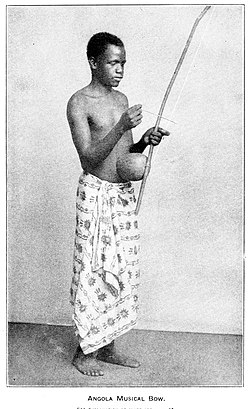
Back باريمباو Arabic Беримбау Bulgarian Berimbau Breton Berimbau Catalan Berimbau Czech Berimbau Danish Berimbau German Berimbao Esperanto Birimbao Spanish Berimbau Finnish
 Angola musical bow (1922), known as berimbau in Brazil. | |
| Other names | urucungo, madimba lungungu |
|---|---|
| Classification | percussion instrument and musical bow |
| Related instruments | |
| Belembaotuyan, Benta, Bobre, Diddley bow, Kalumbu, Malunga, Quijongo, Uhadi, Washtub bass | |
| Sound sample | |
The berimbau (Portuguese pronunciation: [beɾĩˈbaw], borrowed from Kimbundu mbirimbau[1]) is a traditional Angolan musical bow that is commonly used in Brazil.[2] It is also known as Sekitulege among the Baganda and Busoga.[3]
It consists of a single-stringed bow attached to a gourd resonator and is played with a stick and a coin or stone to create different tones and rhythms.
The berimbau was used in many parts of Africa and Brazil during the 19th century to accompany chants and storytelling.[4] It is part of the candomblé tradition, later incorporated into the Afro-Brazilian art capoeira. Until the mid-20th century, it was used almost exclusively within the black community, but after the popularization of capoeira, it gain wider popularity.
Today, berimbau is used in various genres of popular music.
- ^ "Berimbau". 19 November 2023.
- ^ "Royal Museum for Central Africa, Belgium". Retrieved 2015-04-11.
- ^ kawlaw (2022-09-12). "Uganda's Traditional Musical Instruments | Uganda Safaris Tours". Uganda Safaris. Retrieved 2024-01-08.
- ^ Capoeira 2007, pp. 42.
